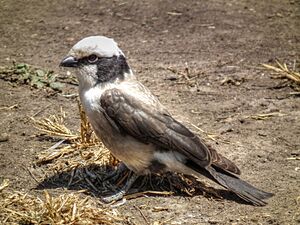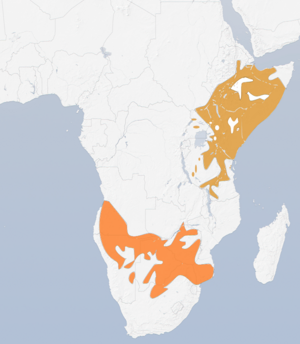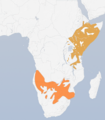Northern white-crowned shrike facts for kids
Quick facts for kids Northern white-crowned shrike |
|
|---|---|
 |
|
| In Tanzania | |
| Conservation status | |
| Scientific classification | |
| Genus: |
Eurocephalus
|
| Species: |
ruppelli
|
 |
|
Range map for the Eurocephalus shrikes
|
|
| Synonyms | |
|
Eurocephalus rueppelli |
|
The northern white-crowned shrike (Eurocephalus ruppelli) is a cool bird found in eastern Africa. You can spot it in places like dry thornbush, semi-desert areas, and open acacia woodlands. Its home stretches from southeastern South Sudan and southern Ethiopia all the way to Tanzania. This bird's scientific name honors Eduard Rüppell, a German naturalist and explorer.
Contents
About the Northern White-Crowned Shrike
What Does It Look Like?
The northern white-crowned shrike is a medium-sized bird, about 19 to 23 centimeters long. That's roughly the length of a standard pencil! Adult birds have a bright white crown on their head and a white rump (the lower part of their back). They also have a black stripe across their eyes. Their back and wings are brown, and their tail is black. The throat, chest, and belly are white, while the sides of their body are brown.
Both male and female shrikes look quite similar. However, young shrikes have a brown crown instead of white. Their head sides are white, and their chest is grey. When they fly, they move in a way that looks a bit like a parrot.
What Sounds Does It Make?
These shrikes make a variety of high-pitched noises. You might hear them squawk, squeak, or chatter. Some of their calls sound like "kek-kek" or "chee-chee."
Life and Habits
Where Do They Live?
Northern white-crowned shrikes love to hang out together. They are very social birds and often live in groups of up to 12 birds.
What Do They Eat?
These shrikes are skilled hunters. They usually sit on a high, open branch, watching for food. Their main diet consists of large insects, which they typically catch from the ground. Sometimes, they even feed on the backs of large mammals, just like oxpeckers do! Occasionally, they will also eat fruit that has fallen to the ground.
Reproduction and Family Life
Northern white-crowned shrikes build a neat, strong nest in the shape of a cup. They make it from grass and spider webs. The nest is usually placed in a horizontal tree fork, about 4 to 6 meters (13 to 20 feet) above the ground.
The female shrike lays two to four eggs. These eggs are white or a light purple color, with blotches of grey, purple, or brown. Because these birds are so social, scientists believe they might practice "cooperative breeding." This means that other birds in the group, not just the parents, help to raise the young. This is also seen in their close relatives, the southern white-crowned shrike.
Images for kids




